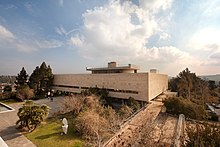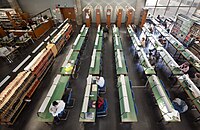Israeli National Library
|
הספריה הלאומית של ישראל المكتبة الوطنية الإسرائيلية The National Library of Israel |
|
|---|---|
|
Photo taken in 2005
|
|
| Library type | National Library |
| place | Jerusalem, Israel |
| ISIL | IL-NNL |
| management | Oren vineyard |
| Website | nli.org.il |
The Israeli National Library (actually: National Library of Israel, Hebrew הספריה הלאומית של ישראל Ha-Siphriah ha-Le'ummith schel Jisra'el , Arabic المكتبة الوطنية الإسرائيلية, DMG al-Maktaba al-Waṭanīya al-Isrāʾīlīya , English The National Library of Israel , until 2010: Jewish National and University Library , JNUB) in Jerusalem is the national library and largest library in Israel . It is located on the Edmond J. Safra Campus of the Hebrew University in the Giv'at Ram neighborhood.
history
Predecessor institutions (B'nai Brith library, Midrash Abraban'el ,מדרש אַבְּרַבַּנְאֵל) were founded since 1892 to collect and archive literature on Judaism comprehensively. In 1896, Joseph Chasanowitsch donated his extensive Białystok book collection of 32,000 volumes with the stipulation to create a national library of all Jewish literature from the Midrash Abravanel library. From 1925 to 2010 the National Library was also the university library of the Hebrew University in Jerusalem.
With the outbreak of the War of Independence in 1948, the library on Mount Scopus in Jerusalem had to close. All of the library's holdings and catalogs, along with general equipment, were on the scopus, which from 1948 to 1967 formed an Israeli enclave in the Jordanian part of Jerusalem that was extremely limited to reach .

After the armistice without access to its holdings and buildings, the remaining staff under main librarian Curt Wormann had to practically rebuild the library. Initially, the National and University Library took over the academic library of the Jeschurun Synagogue in Jerusalem as well as various private collections from professors and students (including the large library of Joseph Klausner ).
Thousands of volumes in the library's current holdings come from Palestinian private households, the residents of which fled or were expelled in 1948, after which their houses were cleared by Israeli soldiers, some together with library staff. From May 1948 to February 1949, the library took over around 30,000 books, magazines and manuscripts that had to be left behind in Jerusalem by Palestinian refugees, as well as holdings from Palestinian schools, mosques and churches. These printed works, less than one percent of the entire library holdings, are cataloged separately and do not belong to the library's actual holdings, but are under the control of the state trustee.
Finally, on March 8, 1949, Main Librarian Wormann was also appointed Director of the National and University Library and a member of the Senate of the Hebrew University . Wormann won the support of the Rockefeller Foundation for a new library building on Giv'at Ram , the new campus of the Hebrew University. In the meantime, the Franciscan Custody of the Holy Land rented the building of the former Collège Terra Sancta to the library, where it then resumed its operations. In 1955, UNESCO approved funds with which the Hebrew University's College of Libraries and Archives opened in 1956.
In 1957 Wormann came back from a long trip to Europe, during which he had established working relationships with the world's major libraries and was able to acquire hundreds of thousands of books stolen during the Nazi persecution of Jews for the national and university libraries. After the end of the Second World War, large quantities of books from former Jewish private collections in Europe and from destroyed Jewish communities were transferred from the Offenbach Archival Depot to the library's holdings through the work of the Jewish Cultural Reconstruction Organization .

With the construction of the Lady Davis building initiated by Wormann on Giv'at Ram in 1960, all library holdings could be brought together in one of the largest and most modern library buildings in the world at the time. After 1966, the National and University Library was able to acquire Jewish manuscripts at auctions in Germany as part of the German deliveries of goods and services to Israel for which the Federal Government paid (the program of German exports called reparation ).
Until the 1970s, the library was mainly under the direction and participation of German-Jewish scholars who either received their training as librarians in Central Europe or were closely connected to this culture and its traditions due to their origins, which affected the The conception of the library and its collection focus clearly had an impact. In addition to Wormann, Hugo Bergmann , Felix Weltsch , Gotthold Weil , Jisrael Adler and Re'uven Jaron (née Richard Rosenkranz) should be mentioned here .
Until the end of 2010 it was the largest university library in the Hebrew University of Jerusalem. Since January 1, 2011, the National Library has been an independent state institution and will have a new building for the foreseeable future. It contains collections for Hebrew Studies, Middle East and Islam Studies, Philosophy, and for the exploration of early Christianity. The four reading rooms of the library correspond to the following areas of knowledge: general reading room (also the largest), the combined reading room for Jewish studies and oriental studies and the newly designed reading room of the music department.
The inventory of books and magazines amounts to around 5.5 million volumes, which have been indexed in an online catalog based on the Aleph 20 system since 1984 . The special collections include manuscripts (around 9,000 Hebrew and 2,000 Arabic) and around 600 bequests from important personalities, including those of Martin Buber , Walter Benjamin , Stefan Zweig , Else Lasker-Schüler , Leopold Zunz , Samuel Agnon and Albert Ehrenstein . The central online catalog records all publications.
In 2014, the project for the new building of the national library was presented to the public. The project, designed by Basel architects Herzog & de Meuron , is due to be completed by 2021. The new building for the national library will be in the immediate vicinity of the Israel Museum and the Knesset , the Israeli parliament.
Special collections
- The Eran Laor map collection of ancient and old maps; Travel reports focusing on the Holy Land and Jerusalem; accessible online.
- The manuscript collection includes over nine thousand Hebrew and two thousand Arabic manuscripts from all areas of science.
- The Gershom Scholem collection of currently approx. 40,000 media, based on Scholem's private library; numerous rarities and manuscripts; Kabbalah, mysticism, history of religion. In the process of digitization; Scholem's Index on the Zohar is also available online. [1] .
- Microfilm collection of Hebrew manuscripts in foreign libraries. A quarter of this is accessible through the online catalog.
literature
- Norbert Weldler : The Jewish National and University Library in Jerusalem /בית הספרים הלאומי והאוניברסיטאי: Your becoming and work (with a foreword by Pierre Bourgeois ), Swiss Association of Friends of the Hebrew University of Jerusalem (ed.), Zurich: Der Scheideweg, 1957.
- Jacob Barnai: Jewish National and University Library. In: Dan Diner (Ed.): Encyclopedia of Jewish History and Culture (EJGK). Volume 3: He-Lu. Metzler, Stuttgart / Weimar 2012, ISBN 978-3-476-02503-6 , pp. 249-251
Web links
- National Library of Israel website (Hebrew, Arabic, English)
Individual evidence
- ↑ His name also appears in other spellings: Hebrew יוסף חזנוביץ, Yiddish יוסף חזנאוויטש, Polish Józef Chazanowicz and Russian Иосиф Аронович Хазанович .
- ↑ See 'Abarbanel Library in Jerusalem (מדרש אברבנל)' , in: Jewish Encyclopedia , accessed on September 22, 2014.
- ↑ Frauke Mahrt-Thomsen, 150 years old: From the Berlin People's Libraries to the Kreuzberg City Library; a chronicle , District Office Kreuzberg of Berlin / Library Office, District Office Kreuzberg of Berlin / Art Office Kreuzberg, District Office Kreuzberg of Berlin / Kreuzberg Museum and Association for Research and Presentation of the History of Kreuzberg (ed.), Berlin: District Office Kreuzberg of Berlin / Library Office, 2000, P. 18. No ISBN.
- ↑ Ofer Aderet: " ספר משוחרר לא יוחזר ", in: Ha'aretz , December 8, 2012. These events are also the subject of the Israeli documentary "שוד הספרים הגדול".
- ↑ Frauke Mahrt-Thomsen, 150 years old: From the Berlin People's Libraries to the Kreuzberg City Library; a chronicle , District Office Kreuzberg of Berlin / Library Office, District Office Kreuzberg of Berlin / Art Office Kreuzberg, District Office Kreuzberg of Berlin / Kreuzberg Museum and Association for Research and Presentation of the History of Kreuzberg (ed.), Berlin: District Office Kreuzberg of Berlin / Library Office, 2000, P. 26. No ISBN.
- ↑ See The Hebrew university, Jerusalem Graduate library school, Announcement for the year 1956-57 , Jerusalem: ֻֻמפעל השכפול, 1956.
- ↑ מרדכי נדב (Mordechai Nadav), "שנות המאבק וההתבססות של ד"ר ק"ד וורמן בתפקיד מנהל בית הספרים הלאומי והאוניברסיטאי (1947–1957)", in: יד לקורא (Jad la-Qôre '), Vol. 27 (1993), p. 12.
- ^ Herzog & de Meuron to Design the National Library of Israel . In: ArchDaily . April 29, 2013 ( archdaily.com [accessed June 5, 2017]).
- ↑ Herzog & de Meuron: Project sketch National Library of Israel, Jerusalem , 2016, accessed on February 25, 2020.
- ↑ The Eran Laor Cartographic Collection , accessed October 31, 2019.
Coordinates: 31 ° 46 ′ 33 ″ N , 35 ° 11 ′ 48 ″ E



